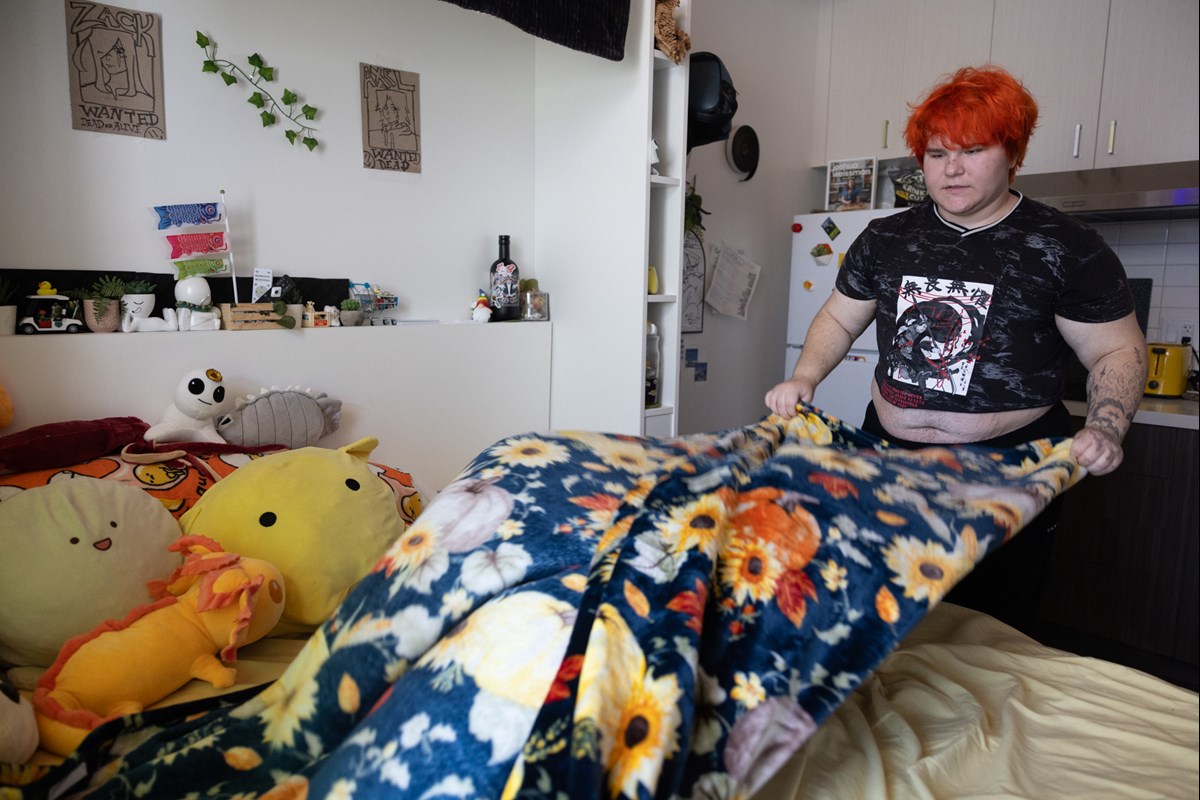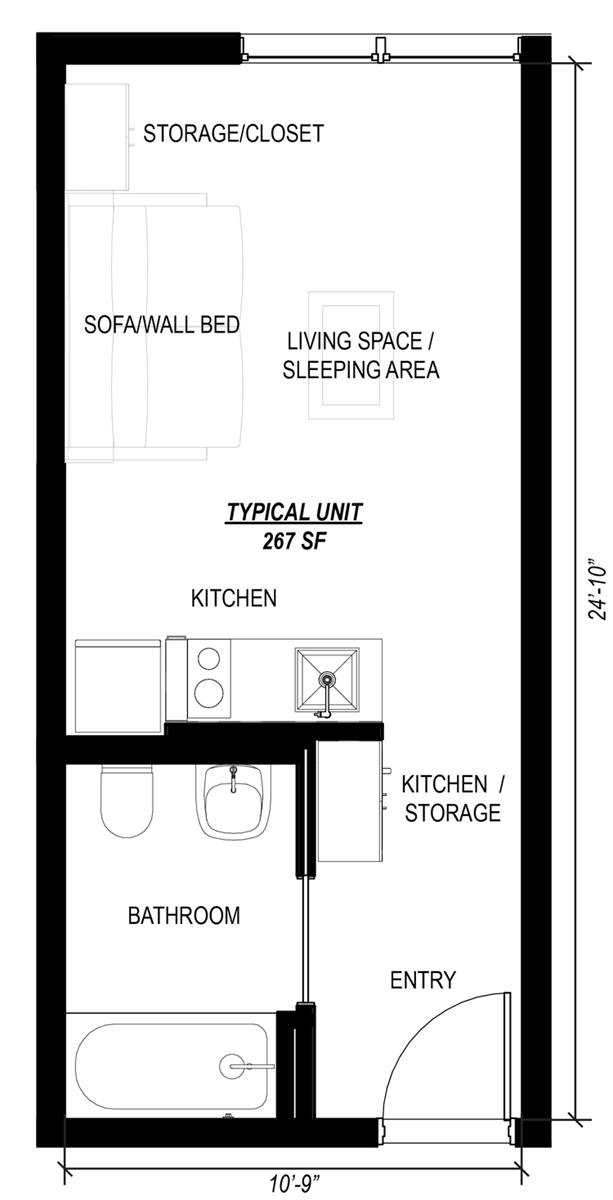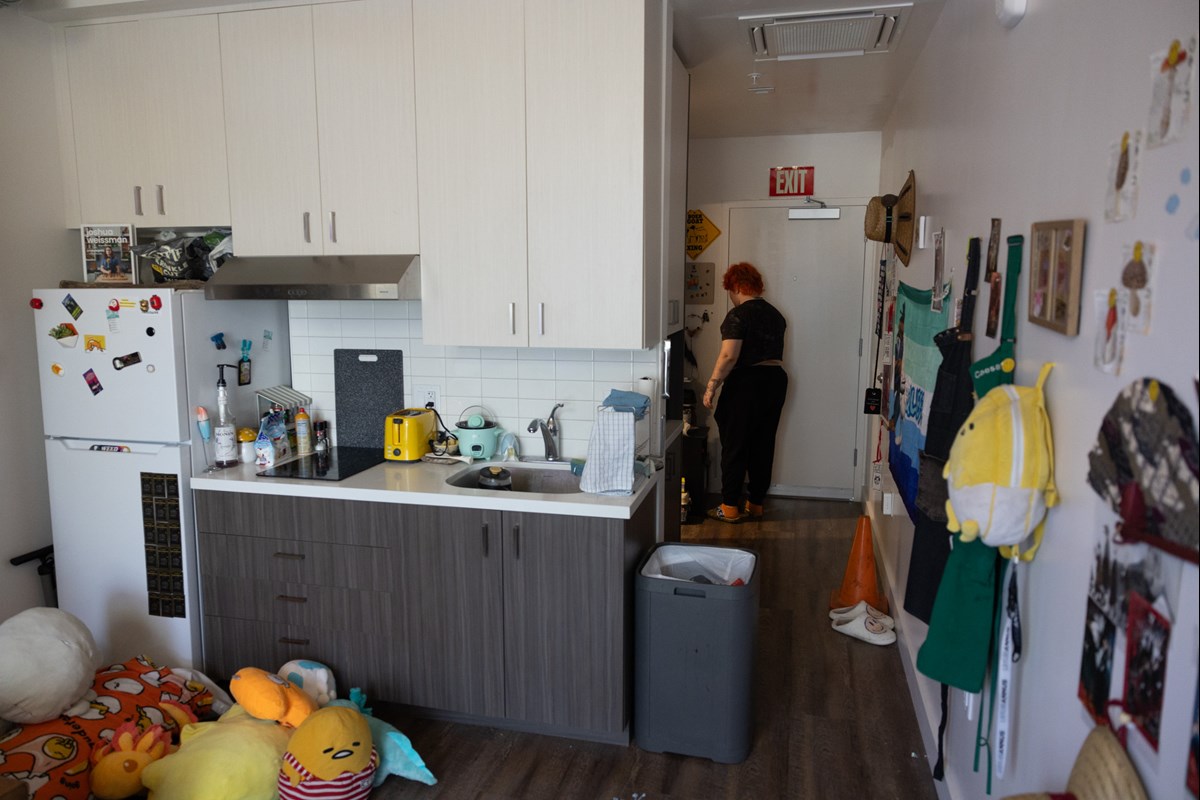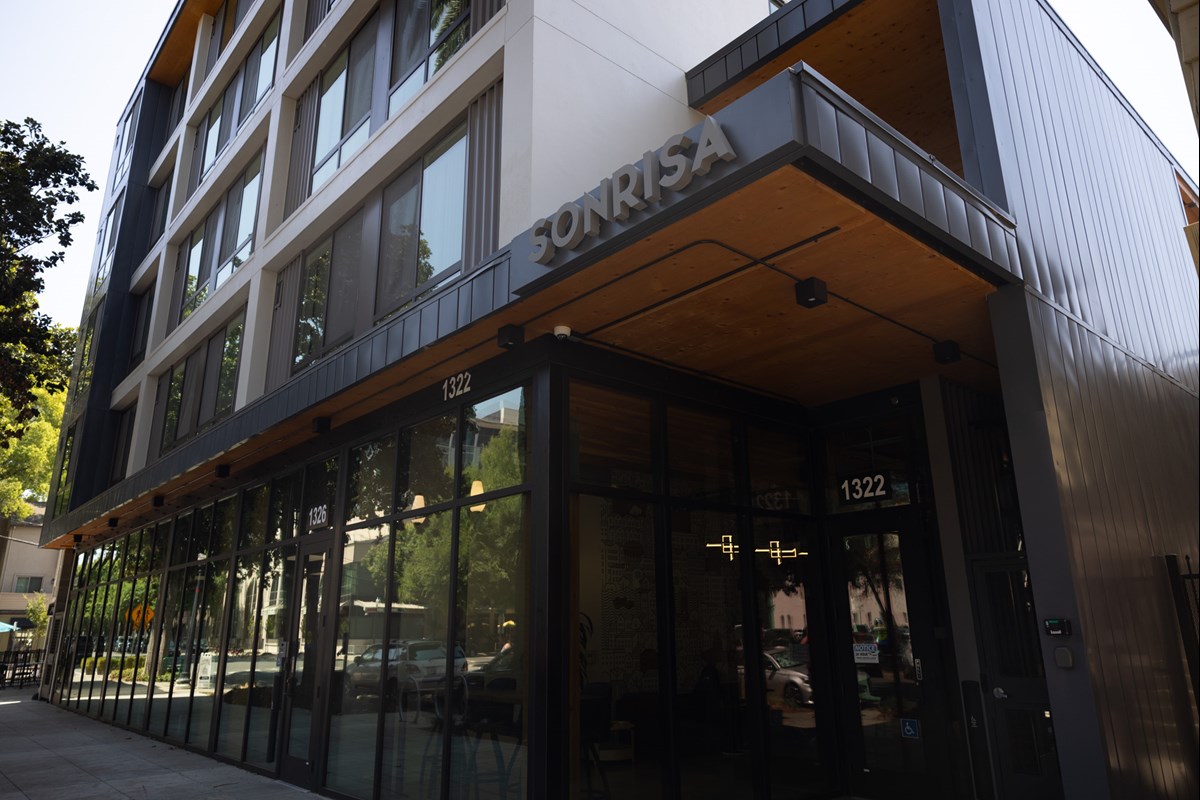Updated Sept. 13, 4:17 p.m.
Caesar LaVey’s 267-square-foot apartment is tucked inside a sleek five-story building called Sonrisa, a new affordable housing community two blocks from the state Capitol in downtown Sacramento.
While living in such a tiny space isn’t for everyone, the 20-year-old renter said it fits his needs “perfectly fine.”
“I don’t stay home too often. I’m either at work or hanging out with friends,” explained LaVey, a Sacramento native, who makes $17.50 an hour as a tailor, has bright orange dyed hair and is quick to laugh.
To save space, LaVey folds his Murphy bed into the wall where it transforms into a couch. He uses a foldable table for meals and rolls his chair under his desk. A floor-to-ceiling window makes the apartment seem larger and provides natural light for his succulents and cacti.
Sonrisa is the third “micro apartment” community to open in the Sacramento region in recent years. While its 58 units are all 267-square-feet, the 11-story 19J in Midtown offers a bit more elbow room with an average of 415 square feet. Meanwhile, studio apartments at West Sacramento’s Kind are a cozy 360 square feet.
 Caesar LaVey readies his Murphy bed to be put away in his micro apartment in Sacramento, Calif., Thursday, Aug. 24, 2023.Andrew Nixon / CapRadio
Caesar LaVey readies his Murphy bed to be put away in his micro apartment in Sacramento, Calif., Thursday, Aug. 24, 2023.Andrew Nixon / CapRadio
Experts said more of these apartments and their below-average rents could ease the affordable housing crisis in Sacramento and cities across California. But they also cautioned that community opposition, a lack of public funding and other concerns could stymie the trend of going small.
Given the Sacramento region’s extreme lack of affordable housing, LaVey said he’s lucky to call his micro unit home. He pays $833 a month in rent, about a thousand dollars below the average apartment rent in a region with a shortfall of nearly 56,000 affordable homes.
That shortfall means young renters like LaVey and anyone with limited means is likely shut out from Sacramento’s traditional housing stock of single-family homes and full-size apartments.
“It’s not that nobody wants to have a big house and kids and things like that,” LaVey said. “It’s that it’s become so completely unaffordable and so far out of anybody else’s reach that we literally just cannot touch it. That’s like dreaming for touching the stars.”
‘How small is too small?’
 A floorplan for a studio apartment at Sonrisa, a new affordable housing community in downtown SacramentoCourtesy Sonrisa
A floorplan for a studio apartment at Sonrisa, a new affordable housing community in downtown SacramentoCourtesy SonrisaHistorically, boarding houses and single room occupancy hotels offered even smaller spaces for people looking for cheap housing in urban areas across California.
But those types of housing fell out of favor during the 20th century due to overcrowding and substandard conditions, said Laxmi Ramasubramanian, an urban planning professor at San Jose State University.
Ramasubramanian said micro apartments have the potential to ease today’s affordable housing crunch, but cities must ensure they meet health, safety and quality of life standards.
“I think we do have to think about ‘How small is too small?’” the professor said. “Because the way people use their home has changed over the past several years. It’s amplified through the pandemic: People work from home.”
Not everyone is so concerned, especially considering today’s dire affordability crisis.
“I don’t see size as being a health or safety issue, particularly when the alternative is a tent,” said Chris Elmendorf, a UC Davis law professor who researches California housing. “We know that it’s not safe to live in a tent on the street.”
Sacramento County’s homeless population hit a record 9,300 people last year, up a staggering 67% from two years earlier, according to the 2022 Point in Time Count. But even with those conditions on the street, community opposition could block more micro apartments in Sacramento, Elmendorf predicted.
That’s what happened in San Francisco a decade ago, he said, after several micro unit projects popped up. Some neighborhood groups derided the housing as “tech dorms” for local tech workers. He said the projects also lost favor among some after a micro apartment complex was converted into a homeless shelter.
Sacramento has a self-described “huge fan” of micro apartments in Mayor Darrell Steinberg. The mayor said, given the painstakingly long time it takes to build traditional housing, he wants communities to mass produce alternatives like micro apartments.
“What I want to see in the state is the tiny home movement [and] manufactured housing move to scale in some form because I worry that we’re not going to catch our tail in terms of trying to keep up with the demand for conventional affordable housing,” Steinberg said.
Sacramento’s city code requires a minimum of 150 square feet of living space in so-called “efficiency units,” another term for micro apartments. The units must also provide a kitchen and bathroom and house no more than two people, according to the code.
Help for more than just young renters
 Caesar LaVey's micro apartment features an induction cook top kitchenette in Sacramento, Calif., Thursday, Aug. 24, 2023.Andrew Nixon / CapRadio
Caesar LaVey's micro apartment features an induction cook top kitchenette in Sacramento, Calif., Thursday, Aug. 24, 2023.Andrew Nixon / CapRadioSupporters of micro apartments say they help more than just young renters. They’re also an affordable option for older residents on a fixed income, for single parents and for people with disabilities who need to access downtown services.
“I think we have a lot of one- and two-person households that are looking for affordable places to live and it’s really hard to do without a second income or a roommate,” said Danielle Foster, executive director of the Capital Area Development Authority, the public agency that developed Sonrisa and opened it in March.
To live at the complex, tenants must make between 40% and 60% of the area median income. The funding for Sonrisa included more than $30 million in state loans, tax-exempt bonds and tax credits, according to CADA, which is a joint powers authority between the city of Sacramento and state of California.
While Sonrisa relied heavily on state funding, Foster said private developers have shown they can build micro apartments without government subsidies.
She pointed to 19J in Midtown, built by Nikki Mohanna of Mohanna Development Co. “I think this project is really kind of showing that it can work from the private sector,” Mohanna told KCRA in 2019 after that project’s opening. “And, you know, we don’t need subsidies in order to make a project happen. We can make it happen through smart design, smart construction technologies.”
Mohanna said, at the time, the project’s smallest units, at 275 square-feet, rented for $995 per month. As of this month, the rent at the smallest unit, 277-square-feet, was $1,495, according to the 19J website.
Big demand for Sonrisa’s micro apartments
 The Sonrisa micro apartments near the Capitol in Downtown Sacramento, Calif., Thursday, Aug 24, 2023.Andrew Nixon / CapRadio
The Sonrisa micro apartments near the Capitol in Downtown Sacramento, Calif., Thursday, Aug 24, 2023.Andrew Nixon / CapRadio
Sacramentans seem eager to rent small spaces, based on demand so far. Foster said Sonrisa’s 58 apartments filled up quickly.
“We have a waiting list of over 860 households right now just for this location. And so we know there’s a great need and a great demand for more housing of this type,” she said.
Seated on his couch inside his apartment, LaVey said the massive waiting list for the complex reinforces how fortunate he is to have a home.
“This was like a diamond, literally, in the rough,” said LaVey, the aprons he wore as a barista at Starbucks hanging on the wall. “I could not have found something better.”
He said he can’t afford to leave, anytime soon.
Contact CapRadio reporter Chris Nichols at [email protected]
Correction: A previous version of this story misidentified Mohanna Development Co. It has been corrected.
Follow us for more stories like this
CapRadio provides a trusted source of news because of you. As a nonprofit organization, donations from people like you sustain the journalism that allows us to discover stories that are important to our audience. If you believe in what we do and support our mission, please donate today.
Donate Today